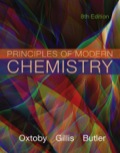
a)
Interpretation: The molecular electronic configuration of
Concept introduction: Two or more than two atomic orbitals overlap to form bond, these orbitals are called molecular orbitals. Count of molecular orbital obtained is same as count of atomic orbitals mixed.
Two forms of molecular orbital are obtained. These are bonding and antibonding orbital.
Bonding orbitals are those in that electrons are in between nucleus of two atom. Antibonding orbitals are those in which electrons are away from nucleus of two-atom. Also, electrons in antibonding orbital have energy high as compared to bonding orbital.
In sigma
In pi
In pi
b)
Interpretation: The bond order of
Concept introduction: Two or more than two atomic orbitals overlap to form bond, these orbitals are called molecular orbitals. Count of molecular orbital obtained is same as count of atomic orbitals mixed.
Two forms of molecular orbital are obtained. These are bonding and antibonding orbital.
Bonding orbitals are those in that electrons are in between nucleus of two atom. Antibonding orbitals are those in which electrons are away from nucleus of two-atom. Also, electrons in antibonding orbital have energy high as compared to bonding orbital.
In sigma
In pi
In pi
c)
Interpretation: The species that is paramagnetic should be determined.
Concept introduction: Two or more than two atomic orbitals overlap to form bond, these orbitals are called molecular orbitals. Count of molecular orbital obtained is same as count of atomic orbitals mixed.
Two forms of molecular orbital are obtained. These are bonding and antibonding orbital.
Bonding orbitals are those in that electrons are in between nucleus of two atom. Antibonding orbitals are those in which electrons are away from nucleus of two-atom. Also, electrons in antibonding orbital have energy high as compared to bonding orbital.
In sigma
In pi
In pi
d)
Interpretation: The ion that has high
Concept introduction: Two or more than two atomic orbitals overlap to form bond, these orbitals are called molecular orbitals. Count of molecular orbital obtained is same as count of atomic orbitals mixed.
Two forms of molecular orbital are obtained. These are bonding and antibonding orbital.
Bonding orbitals are those in that electrons are in between nucleus of two atom. Antibonding orbitals are those in which electrons are away from nucleus of two-atom. Also, electrons in antibonding orbital have energy high as compared to bonding orbital.
In sigma
In pi
In pi
Want to see the full answer?
Check out a sample textbook solution
Chapter 6 Solutions
EBK PRINCIPLES OF MODERN CHEMISTRY
- Draw the major product of this reaction. Ignore inorganic byproducts and the amine side product. 'N' 1. NaOH, heat 2. Neutralizing work-up Select to Drawarrow_forwardSubmit Problem 3 of 10 Draw the major product of this reaction. Ignore inorganic byproducts and the amine side product. O 'N' NH 1. NaOH, heat 2. Neutralizing work-up Select to Drawarrow_forwardb) Certain cyclic compounds are known to be conformationally similar to carbohydrates, although they are not themselves carbohydrates. One example is Compound C shown below, which could be imagined as adopting four possible conformations. In reality, however, only one of these is particularly stable. Circle the conformation you expect to be the most stable, and provide an explanation to justify your choice. For your explanation to be both convincing and correct, it must contain not only words, but also "cartoon" orbital drawings contrasting the four structures. Compound C Possible conformations (circle one): Детarrow_forward
- Lab Data The distance entered is out of the expected range. Check your calculations and conversion factors. Verify your distance. Will the gas cloud be closer to the cotton ball with HCI or NH3? Did you report your data to the correct number of significant figures? - X Experimental Set-up HCI-NH3 NH3-HCI Longer Tube Time elapsed (min) 5 (exact) 5 (exact) Distance between cotton balls (cm) 24.30 24.40 Distance to cloud (cm) 9.70 14.16 Distance traveled by HCI (cm) 9.70 9.80 Distance traveled by NH3 (cm) 14.60 14.50 Diffusion rate of HCI (cm/hr) 116 118 Diffusion rate of NH3 (cm/hr) 175.2 175.2 How to measure distance and calculate ratearrow_forwardFor the titration of a divalent metal ion (M2+) with EDTA, the stoichiometry of the reaction is typically: 1:1 (one mole of EDTA per mole of metal ion) 2:1 (two moles of EDTA per mole of metal ion) 1:2 (one mole of EDTA per two moles of metal ion) None of the abovearrow_forwardPlease help me solve this reaction.arrow_forward
- Indicate the products obtained by mixing 2,2-dimethylpropanal with acetaldehyde and sodium ethoxide in ethanol.arrow_forwardSynthesize 2-Ethyl-3-methyloxirane from dimethyl(propyl)sulfonium iodide using the necessary organic or inorganic reagents. Draw the structures of the compounds.arrow_forwardSynthesize 2-Hydroxy-2-phenylacetonitrile from phenylmethanol using the necessary organic or inorganic reagents. Draw the structures of the compounds.arrow_forward
- Synthesize N-Methylcyclohexylamine from cyclohexanol using the necessary organic or inorganic reagents. Draw the structures of the compounds.arrow_forwardSynthesize N-Methylcyclohexylamine from cyclohexanol using the necessary organic or inorganic reagents. Draw the structures of the compounds.arrow_forwardIf possible, please provide the formula of the compound 3,3-dimethylbut-2-enal.arrow_forward
 Chemistry: Principles and ReactionsChemistryISBN:9781305079373Author:William L. Masterton, Cecile N. HurleyPublisher:Cengage Learning
Chemistry: Principles and ReactionsChemistryISBN:9781305079373Author:William L. Masterton, Cecile N. HurleyPublisher:Cengage Learning Chemistry: Principles and PracticeChemistryISBN:9780534420123Author:Daniel L. Reger, Scott R. Goode, David W. Ball, Edward MercerPublisher:Cengage Learning
Chemistry: Principles and PracticeChemistryISBN:9780534420123Author:Daniel L. Reger, Scott R. Goode, David W. Ball, Edward MercerPublisher:Cengage Learning
 ChemistryChemistryISBN:9781305957404Author:Steven S. Zumdahl, Susan A. Zumdahl, Donald J. DeCostePublisher:Cengage Learning
ChemistryChemistryISBN:9781305957404Author:Steven S. Zumdahl, Susan A. Zumdahl, Donald J. DeCostePublisher:Cengage Learning Chemistry: An Atoms First ApproachChemistryISBN:9781305079243Author:Steven S. Zumdahl, Susan A. ZumdahlPublisher:Cengage Learning
Chemistry: An Atoms First ApproachChemistryISBN:9781305079243Author:Steven S. Zumdahl, Susan A. ZumdahlPublisher:Cengage Learning Chemistry & Chemical ReactivityChemistryISBN:9781337399074Author:John C. Kotz, Paul M. Treichel, John Townsend, David TreichelPublisher:Cengage Learning
Chemistry & Chemical ReactivityChemistryISBN:9781337399074Author:John C. Kotz, Paul M. Treichel, John Townsend, David TreichelPublisher:Cengage Learning





